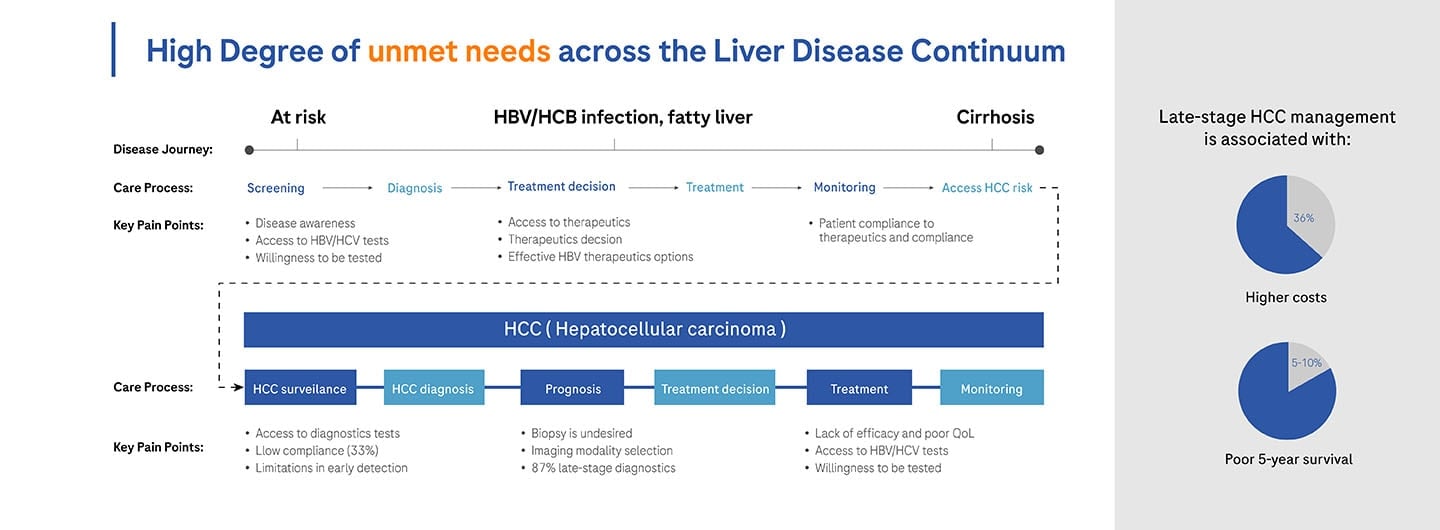High degree of unmet needs across the Liver Disease Continuum Late-stage HCC management is associated with higher cost (36%) & poor 5-year survival (5-10%).
The liver, located in the upper right quadrant of the body and below the diaphragm, is responsible for several functions including detoxification of metabolites, synthesizing proteins, and producing digestive enzymes. Its deterioration over time due to risk factors such as viral hepatitis, metabolic dysfunction, cirrhosis, fatty liver, and more is a classic example of the need to intervene earlier, through appropriate diagnosis, so as to better manage later complications like cancer.
Globally, 1.5 billion people suffer from chronic liver disease, leading to two million annual deaths. What’s more, chronic liver disease is of particular importance to the Asia Pacific given its high prevalence – 72% of liver cancer deaths are found in this region, and it is known as a “silent killer” due to late diagnosis.
Typically, the first tell-tale sign is inflammation due to infection, known as Viral Hepatitis. Symptoms may include fever, fatigue, pain, metabolic dysfunction, and even jaundice. The most common types of viral hepatitis are Hepatitis A, B, and C, which are not distinguishable by symptoms and, thus, require proper diagnostic technique. Transmission can be as simple as contact with infected individuals, leading to, likely, hundreds of millions of carriers (many unbeknownst) around the world. Particularly of the B and C variety, Viral Hepatitis necessitates rapid interventions like direct-acting antiviral agents.
Worse yet, however, is the progression of Viral Hepatitis in the liver into full-fledged cancer, known as Hepatocellular Carcinoma (HCC). HCC accounts for 90% of liver cancers globally, the sixth most common type of cancer. Over 750,000 people are diagnosed with HCC annually and most often, unfortunately, in the late stages of the disease; nearly 50% of cases are in China alone, due to the country’s high prevalence of Viral Hepatitis B and C. Obesity and alcohol abuse are major contributing factors, which are of rising relevance to governments in the Asia Pacific.

This is where the story shows the potential, yet undervalue, of diagnostics. The testing technologies are already widely available – from HBV and HCV screening (e.g. HBsAg, anti-HBs, anti-HCV serology tests), to diagnosis, treatment decision-making and monitoring, to more advanced procedures such as ultrasound imaging or, increasingly, AFP and PIVKA-II surveillance tests as a biomarker to catch the oncogenesis progression much earlier and as a more precise means to determine tumor stage. Indeed, biomarker diagnostic technologies are seen as the future for convenient, inexpensive, non-invasive, and repeatable identification of liver diseases.
Despite the promise, more than half of HCC cases are diagnosed in the later stages of the disease, when the five-year survival rate is less than 10%. Studies show that in the Asia Pacific, closer to 80% of HCC cases are diagnosed in such a stage. Fortunately, discussions are underway to evolve how biomarkers and other diagnostic technologies are adopted in the region to improve early detection. Upon the incorporation by the European Association for the Study of the Liver (EASL) in 2019 of Hepatitis B and C screening as standard of care for primary HCC prevention, the Japanese Society of Hepatology (JSH), with its expert panel on HCC, updated their clinical practice manual in 2021 to include the PIVKAII biomarker screening approach in its fourth edition revision. In essence, the three prongs of effective liver disease progression management, through greater access to diagnostic technologies, can be summarized as: tackling the risk factors (through HBV/HCV management), earlier identification of those patients with chronic issues, and, ultimately, the surveillance therein in order to pick up early-stage HCC that could potentially benefit from curative therapy.
HCC mortality rates have shown to decrease by as much as 37% through earlier and more advanced diagnostics while survival rates jumped to over 50%, as compared to 27% using more limited protocols. Through screening, surveillance, and other preventative testings, patients that are identified early were able to benefit from curative care with prolonged survival. We hope to see more markets in the Asia Pacific consider the value delivered through these liver diagnostic innovations.

Diagram adapted from ‘Strengthening Healthcare Systems Through the Critical Role of Diagnostics.
Download the whitepaper here.






